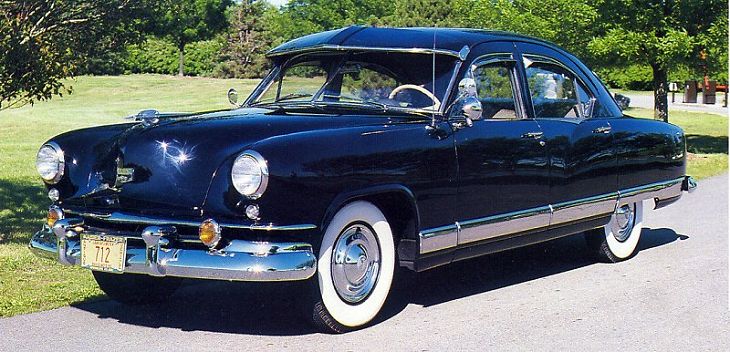Description
The Kaiser DeLuxe was one of the signature models of the Kaiser-Frazer Corporation, a car that captured the optimism and design innovation of postwar America. Produced through the late 1940s and early 1950s, it represented the brand’s commitment to modern styling, practicality, and comfort at a time when most automakers were still recovering from wartime production halts. Positioned above the entry-level Special, the DeLuxe offered a step up in refinement and style, embodying Henry J. Kaiser’s vision of an automobile that was both progressive and accessible to the growing American middle class.
When it debuted in 1947, the Kaiser line was revolutionary. Unlike many competitors who reintroduced reworked prewar designs, Kaiser launched an entirely new car built around a fresh postwar concept. The DeLuxe trim emphasized comfort and aesthetic sophistication, combining sleek, contemporary styling with sound engineering. Its design, guided by Howard “Dutch” Darrin, was notably clean and elegant. Gone were the separate fenders and running boards of earlier cars—in their place stood a smooth, integrated body with sweeping lines and a sense of motion even at rest. The wide horizontal grille and broad stance gave it a confident, modern look that set it apart from Detroit’s more conservative offerings.
Under the hood, the Kaiser DeLuxe shared its mechanical foundation with the rest of the range, powered by the reliable 226 cubic inch (3.7-litre) inline-six Continental Red Seal engine. Producing around 112 horsepower, it delivered smooth and dependable performance through a three-speed manual gearbox, with optional overdrive available for better fuel efficiency and quieter highway cruising. The engine was known for its durability and quietness, more focused on comfort and economy than outright power. The drivetrain and suspension—independent front coils and semi-elliptic rear springs—gave the DeLuxe a refined, stable ride that compared favorably to its more established rivals.
The Kaiser DeLuxe distinguished itself through its interior appointments and attention to comfort. The cabin was spacious, thanks to the car’s long 123.5-inch wheelbase and innovative packaging that maximized passenger space. Inside, high-quality upholstery in fine broadcloth or mohair came standard, with tasteful two-tone options available. The dashboard was symmetrical and well laid out, featuring large round gauges and polished metal trim that reflected the art deco influences of the era. Chrome detailing was used sparingly but effectively, adding a sense of refinement without being ostentatious. Optional extras such as a push-button radio, heater, clock, and defroster allowed buyers to tailor their cars to taste.
Riding in a Kaiser DeLuxe was a comfortable experience. The combination of a smooth suspension, quiet drivetrain, and well-insulated cabin gave it a level of refinement rare among independent manufacturers. Its wide seats and generous legroom made long journeys pleasant, while its large windows and thin roof pillars created a light, airy feel inside. Visibility was excellent, and thoughtful design touches—such as a low floor and wide-opening doors—made the car easy to enter and exit.
On the road, the DeLuxe delivered confident handling for its size. The independent front suspension gave it stability and composure on rough roads, while the large hydraulic brakes provided secure stopping power. Though acceleration was leisurely, the Continental six provided ample torque for steady cruising, and the car’s overall balance between performance, comfort, and control reflected the engineering competence behind its design.
The DeLuxe’s exterior presentation reinforced its role as the refined member of the Kaiser family. Brightwork accents adorned the beltline, grille, and window surrounds, while color-keyed wheels and polished hubcaps added visual appeal. Paint colors were typically soft, elegant shades—blues, greens, maroons, and silvers—that highlighted the car’s graceful curves. The proportions were well-judged, giving the DeLuxe a dignified, forward-looking appearance that aged gracefully through the years.
The 1949 and 1950 models saw refinements to the DeLuxe trim, with updated grilles, improved interior materials, and subtle styling revisions to keep the car fresh. In later years, Kaiser introduced even more upscale variants such as the Manhattan and the hardtop Virginian, but the DeLuxe remained the backbone of the lineup—offering luxury touches without the higher price tag.
Kaiser-Frazer’s success with cars like the DeLuxe was remarkable for an independent manufacturer. In the late 1940s, the company briefly ranked among the top five American automakers, outselling some long-established names. The DeLuxe helped secure this reputation by proving that innovation and good design could attract customers even without the vast resources of the Big Three. Its clean, unpretentious lines and practical comfort appealed to families seeking something modern yet dependable.
Today, the Kaiser DeLuxe is appreciated as a classic example of postwar American optimism and industrial creativity. Collectors value its distinctive styling, solid construction, and the historical significance of the Kaiser-Frazer enterprise—a company that dared to challenge Detroit at its own game. Restored examples display a timeless elegance, their flowing forms and wide chrome grilles evoking an era when the automobile symbolized progress and freedom.
The DeLuxe stood as a perfect expression of Henry J. Kaiser’s belief that innovation and quality could overcome size and tradition. It was not the fastest or the flashiest car of its time, but it was one of the most forward-thinking—an automobile that offered beauty, comfort, and practicality in a way that spoke to postwar America’s desire for something new. In the Kaiser DeLuxe, that promise of modern motoring found one of its finest forms.
